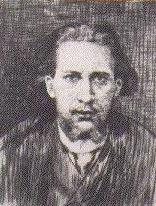
G.-Albert Aurier
Mercure de France, January, 1890

Such . . . is the impression left upon the retina when it first views the strange, intense, and feverish work of Vincent van Gogh, that compatriot, and unworthy descendent of the old Dutch masters.
Oh! How far are we--are we not?--from the beautiful, great traditional art, so healthy and very well balanced, of the Dutch past. How far from the . . . de Hooghes, the van der Meers, the van der Heydens and from their charming canvases, a bit bourgeois, so patiently detailed, so phlegmatically overfinished, so scrupulously meticulous! How far from the handsome landscapes, so restrains, so well balanced, so timelessly enveloped in soft tones, grays, and indistinct haze, those . van Ostades, Potters, van Goyens, Ruisdaels, Hobbemas! . . . How far from the delicate, always somewhat cloudy and somber colours of the northern countries . . . .
And yet, make no mistake, Vincent van Gogh has by no means transcended his heritage. He was subject to the effect of the ineluctable atavistic laws. He is good and duly Dutch, of the sublime lineage of Frans Hals.
And foremost, like all his illustrious compatriots, he is indeed a realist, a realist in the fullest sense of the term. Ars est homo, additus naturae, Chancellor Bacon said, and Monsieur Emile Zola defined naturalism as "nature seen through the temperament." Well, it is this "homo additus," this "through a temperament," or this molding of the objective unity into a subjective diversity, that complicates the question and abolishes the possibility of any absolute criterion for gauging the degrees of the artist's sincerity. To determine this, the critic is thus inevitably reduced to more or less hypothetical, but always questionable, conclusions. Nevertheless, in the case of Vincent van Gogh, in my opinion, despite the sometimes misleading strangeness of his works, it is difficult for an unprejudiced and knowledgeable viewer to deny or question the naive truthfulness of his art, the ingeniousness of his vision. Indeed, independent of this indefinable aroma of good faith and of the truly seen that all his paintings exude, the choice of subjects, the constant harmony between the most excessive colour notes, the conscientious study of character, the continual search for the essential sign of each thing, a thousand significant details undeniably assert his profound and almost childlike sincerity, his great love for nature and for truth--his own personal truth.
Given this, we are thus able to infer legitimately from Vincent van Gogh's works themselves his temperament as a man, or rather, as an artist--an inference that I could, if I wished, corroborate with biographical facts. What characterizes his works as a whole is its excess . . . of strength, of nervousness, its violence of expression. In his categorical affirmation of character of things, in his often daring simplification of forms, in his insolence in confronting the sun head-on, in the vehement passion of his drawing and colour, even to the smallest details of his technique, a powerful figure is revealed . . . masculine, daring, very often brutal . . . yet sometimes ingeniously delicate . . . .
Yet, this respect and his love for the reality of things does not suffice alone to explain or to characterize the profound, complex, and quite distinctive art of Vincent van Gogh. No doubt, like all the painters of his race, he is very conscious of material reality, of its importance and its beauty, but even more often, he considers this enchantress only as a sort of marvelous language destined to translate the Idea. He is, almost always, a Symbolist . . . who feels the continual need to clothe his ideas in precise, ponderable, tangible forms, in intensely sensual and material exteriors. In almost all his canvases, beneath this morphic exterior, beneath this flesh that is very much flesh, beneath this matter that is very much matter, there lies, for the spirit, that knows how to find it, a thought, an idea, and this Idea, the essential substratum of the work, is, at the same time, its efficient and final cause. As for the brilliant and radiant symphonies of colour and line, whatever may be their importance for the painter in his work they are simply expressive means, simply methods of symbolization. Indeed, if we refuse to acknowledge the existence of these idealistic tendencies beneath this naturalist art, a large part of the body of work that we are studying would remain utterly incomprehensible. How would we explain, for example, The Sower that august and disturbing sower, that rustic with his brutally brilliant forehead (bearing at times a distant resemblance to the artist himself), whose silhouette, gesture, and labour have always obsessed Vincent van Gogh, and whom he painted and repainted so often, sometimes beneath skies rubescent at sunset, sometimes amid the golden dust of blazing noons--how could we explain The Sower without considering that idée fixe. that haunts his brain about the necessary advent of a man, a messiah, sower of truth, who would regenerate the decrepitude of our art and perhaps our imbecile and industrialist society? And how could we explain that obsessive passion for the solar disk that he loves to make shine forth from his emblazoned skies, and, at the same time, for that other sun, that vegetable-star, the sumptuoous sunflower, which he repeats, tirelessly, monomaniacally, if we refuse to accept his persistent preoccupation with some vague and glorious heliomythic allegory?
Source: Van Gogh: The Passionate Eye by Pascal Bonafoux (Discoveries, 1992)
 Return to main Van Gogh page
Return to main Van Gogh page